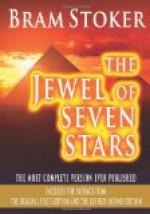“What her intentions were when once she trod the open earth afresh we do not know, and we never shall, unless her own dead lips can soften and speak.”
Chapter XV The Purpose of Queen Tera
“Now, as to the Star Jewel! This she manifestly regarded as the greatest of her treasures. On it she had engraven words which none of her time dared to speak.
“In the old Egyptian belief it was held that there were words, which, if used properly—for the method of speaking them was as important as the words themselves—could command the Lords of the Upper and the Lower Worlds. The ‘hekau’, or word of power, was all-important in certain ritual. On the Jewel of Seven Stars, which, as you know, is carved into the image of a scarab, are graven in hieroglyphic two such hekau, one above, the other underneath. But you will understand better when you see it! Wait here! Do not stir!”
As he spoke, he rose and left the room. A great fear for him came over me; but I was in some strange way relieved when I looked at Margaret. Whenever there had been any possibility of danger to her father, she had shown great fear for him; now she was calm and placid. I said nothing, but waited.
In two or three minutes, Mr. Trelawny returned. He held in his hand a little golden box. This, as he resumed his seat, he placed before him on the table. We all leaned forward as he opened it.
On a lining of white satin lay a wondrous ruby of immense size, almost as big as the top joint of Margaret’s little finger. It was carven—it could not possibly have been its natural shape, but jewels do not show the working of the tool—into the shape of a scarab, with its wings folded, and its legs and feelers pressed back to its sides. Shining through its wondrous “pigeon’s blood” colour were seven different stars, each of seven points, in such position that they reproduced exactly the figure of the Plough. There could be no possible mistake as to this in the mind of anyone who had ever noted the constellation. On it were some hieroglyphic figures, cut with the most exquisite precision, as I could see when it came to my turn to use the magnifying-glass, which Mr. Trelawny took from his pocket and handed to us.
When we all had seen it fully, Mr. Trelawny turned it over so that it rested on its back in a cavity made to hold it in the upper half of the box. The reverse was no less wonderful than the upper, being carved to resemble the under side of the beetle. It, too, had some hieroglyphic figures cut on it. Mr. Trelawny resumed his lecture as we all sat with our heads close to this wonderful jewel:




